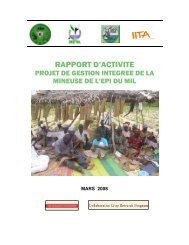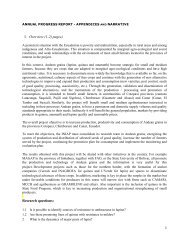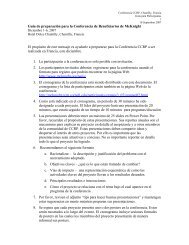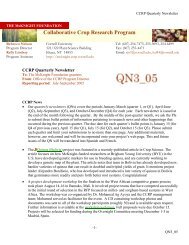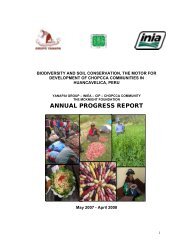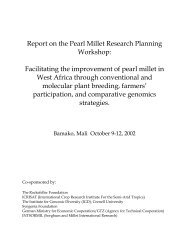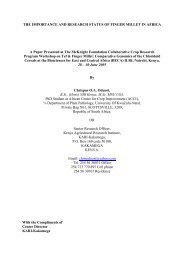English - McKnight Foundation Collaborative Crop Research Program
English - McKnight Foundation Collaborative Crop Research Program
English - McKnight Foundation Collaborative Crop Research Program
You also want an ePaper? Increase the reach of your titles
YUMPU automatically turns print PDFs into web optimized ePapers that Google loves.
<strong>McKnight</strong> <strong>Foundation</strong> <strong>Collaborative</strong> <strong>Crop</strong>s <strong>Research</strong> Project No: 06-741<br />
Poor resistance to A. vogelii. Well liked by farmers.<br />
54 Farmers’ local Collected from around trial sites, usually bushy and long maturing.<br />
1.2 Screening for Alectra resistance.<br />
The sites at Ngwangwa and Kasungu had high infestation of Alectra, even though yields were good..<br />
However, within the plots, spots that had high numbers of Alectra were causing stunted growth and<br />
wilting on cowpea plants. Observations on Alectra resistance showed that in sites with high pressure, all<br />
entries succumbed to the parasite, though differentilly. In lightly infested sites, some entries showed<br />
resistance (Table 3). .At Mngwangwa, where pressure was high, the same lines showed fair resistance.<br />
At Lisasadzi, with high Alectra pressure, entries IT97K-825-15 and IT99K-494-6 showed good<br />
resistance. At Bunda College, with high Alectra pressure, the same three lines showed resistance. On the<br />
overall, entry 21 (IT99K-494-6) and entry 9 (IT99K-7-21-2-2-1) were best for resistance with 0.28 and<br />
0.29Alectra plants m -2 respectively, and entry 21 having zero Alectra count at Bunda. Depending on<br />
yield and other results, one of these three could be released. However, all these have longer maturity<br />
periods.<br />
As these observations were done in presence of local extension and farmers, this gave a good<br />
opportunity to orient farmers to the Alectra problem and the objectives of the project. Since the entries<br />
in the trial were combination of early and late maturing types, the general farmers preference at all sites<br />
was for the early types IT82E-16 and Sudan 1. At Kasungu farmers particularly noted that IT97K-825-<br />
15 was undesired due to its late maturity, as it would need more rains. Some of the other reasons for<br />
preferences were grain size (large size preferred).<br />
Table 3 Alectra counts m -2 taken after flowering at all the trial sites<br />
Entrycode<br />
name<br />
& Bunda Lisasadzi Ngwangwa Mpokwa Rivirivi Chitedze Mean<br />
5=IT98K-503-1 1.35 0.50 3.33 0.6 0.0 0.05 0.97<br />
37=IT97K-825-<br />
15<br />
0.08 0.70 0.60 0.03 0.08 0.25 0.29<br />
9=IT99K-7-21-2-<br />
2-1<br />
0.25 1.38 1.46 0.11 0.0 0.17 0.56<br />
21=IT99K-494-6 0.00 0.60 1.02 0.04 0.03 0.0 0.28<br />
53=Sudan-1 5.82 3.56 4.03 0.86 0.0 0.58 2.48<br />
52=IT82E-16 6.25 6.70 2.86 0.96 0.14 0.0 2.82<br />
54=Farmers’<br />
local<br />
2.80 1.14 3.29 - 0.03 0.11 1.23<br />
Mean 2.36 2.08 2.43 0.44 0.04 0.17 1.25<br />
P



